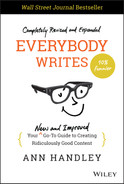24
Add Obvious Structure to a List
A friend asked me to look at a few chapters of a book he's writing. It's a strong book with a strong premise. But he's struggling with making the writing equally buff.
So together let's live-edit a single paragraph right here, right now. Because the writing takeaway is a solid one you can apply to blog posts, emails, video scripts, landing pages … or any kind of writing.
* * *
In a paragraph about a broken business model, my friend had written this:
So why is it that we cling to a model invented before the first flight? An idea conceived of before the age of the Internet? A framework designed before the invention of rockets, submarines, personal computers, television, and radio?
Very conversational, yes? I like that.
But the list of modern inventions and conveniences (rockets, subs, and so on) is a little muddled, for two reasons.
- The order is off. Chronologically, radio came before television. PCs came after both.
- My brain wandered away from the text for a moment: “Wait, when were rockets invented? Or submarines? World War II? World War I? Even before?”
I dunno. Do you?
Unlike radio and TV and PCs, rockets and submarines are not strongly associated with any one period. (At least by most of us. Dear naval and ballistic-missile history buffs: I see you.)
Our brains look for patterns—rhythm, rhyme, repetition, parallel structure, or (in this case) order from disorder. Patterns help us make sense of the world.
From chaos, writers bring order.
In a list of things, add obvious structure.
Each item in a list must relate to the others around it in an unmistakable way.
Why: Without structure, our brains scramble to create order from the disorder. The reader will have to work harder than they should—even if only subconsciously.
I also think my friend is missing an opportunity here. He could be choosing things that might be more personally relevant to digitally savvy business readers—the book's intended audience.
I'd also toss in a little playfulness, because why not?
A better way to convey the idea would be to:
- Make the list chronological, suggesting progress and progression.
- Use more commonly known markers of time.
Then, go one step further:
- Exchange the items listed for items that will resonate with the readers he's writing to, in the context of the story he's telling.
Here's our live-edit:
So why is it that we cling to a model conceived before Henry Ford's Model T?
A framework designed before the invention of the airplane, television, the Apple IIe?
Before Al Gore and the Internet itself?
Those items (Model T, airplane, TV) aren't the only markers we might use, of course.
But here they work in the broader context of the book and the audience who will read it—the kind of people who have a general idea of when the television was invented and who definitely remember the long, happy life of the Apple IIe.
Plus we added paragraph breaks to give the writing more air. More room on the landing strip to really bring the point home.
Why does structure matter to our writing?
Our brains crave order—structure, patterns, parallelism. Your job as a writer is to create that order.
Your job is to be a tour guide to ideas: self-assured, clear.
Your job is to light the path for your reader and kick debris and roadblocks out of the way.
You aren't a terrible tour guide, zigzagging a band of tourists through meandering, unexplained detours; highlighting irrelevant details; risking twisted ankles in potholed streets.
That kind of tour guide creates anxiety in tourists.
That kind of writer creates anxious readers.
The clearer the writer is, the more secure a reader feels. The more relaxed the readers, the more they're free to enjoy the journey, secure in the knowledge that the writer is capable, in control of the GPS wheel.
Or the tour-guide flag.
Or whatever.
You know what I mean.
